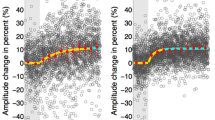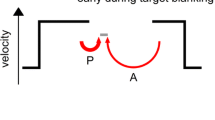Abstract
Eye movements were recorded electro-oculographically in three patients with a small ischemic lesion affecting the left frontal eye field (FEF) and in 12 control subjects. Reflexive visually guided saccades (gap and overlap tasks), antisaccades, predictive saccades, memory-guided saccades, smooth pursuit and optokinetic nystagmus (OKN) were studied in the three patients. Staircase saccades and double step saccades were also studied in one of the three patients. For both leftward and rightward saccades, latency in the overlap task (but not in the gap task) and that of correct antisaccades and of memory-guided saccades was significantly increased, compared with the results of controls. There was a significant decrease in the amplitude gain of all rightward saccades programmed using retinotopic coordinates (gap and overlap tasks, predictive and memory-guided saccades), whereas the amplitude gain of corresponding leftward saccades was preserved. Such an asymmetry between leftward and rightward saccades was significant. In the staircase paradigm as well as for the first saccade in the double step paradigm (with the use of retinotopic coordinates in both cases), the amplitude gain of rightward saccades was also significantly lower than that of leftward saccades. Moreover, in the double step paradigm, the amplitude gain of the first rightward saccade was significantly lower than that of the second rightward saccade (programmed using extraretinal signals), which was preserved. The percentage of errors in the antisaccade task did not differ significantly from that of normal subjects. In the predictive saccade paradigm, the percentage of predictive rightward saccades was significantly decreased. The left smooth pursuit gain for all tested velocities, the right smooth pursuit gain for higher velocities, and the left OKN gain were significantly decreased. The results show, for the first time in humans, that the FEF plays an important role in (1) the disengagement from central fixation, (2) the control of contralateral saccades programmed using retinotopic coordinates, (3) saccade prediction and (4) the control of smooth pursuit and OKN, mainly ipsilaterally. In contrast, the left FEF did not appear to be crucial for the control of the only type of saccades programmed using extraretinal signals studied here.
Similar content being viewed by others
References
Andersen RA, Asanuma C, Essick G, Siegel RM (1990a) Corticocortical connections of anatomically and physiologically defined subdivisions within the inferior parietal lobule. J Comp Neurol 296:65–113
Andersen RA, Bracewell M, Barash S, Gnadt J, Fogassi L (1990b) Eye position effects on visual, memory, and saccade-related activity in areas LIP and 7a of macaque. J Neurosci 10:1176–1196
Baloh RW, Yee RD, Honrubia V (1980) Optokinetic nystagmus and parietal lobe lesions. Ann Neurol 7:269–276
Becker W (1989) Metrics. Rev Oculomot Res 3:13–67
Bon L, Lucchetti C (1992) The dorsomedial frontal cortex of the macaca monkey: fixation and saccade-related activity. Exp Brain Res 89:571–580
Braun D, Weber H, Mergner TH, Schulte-Mönting J (1992) Saccadic reaction times in patients with frontal and parietal lesions. Brain 115:1359–1386
Bruce CJ (1990) Integration of sensory and motor signals in primate frontal eye fields. In: Edelman GM, Gall EW, Cowan WM (eds) Signal and sense. Wiley-Liss, New York, pp 261–314
Bruce CJ, Goldberg ME (1985) Primate frontal eye fields. I. Single neurons discharging before saccades. J Neurophysiol 53:603–635
Chain F, Leblanc M, Chedru F, Lhermitte F (1979) Négligence visuelle dans les lésions postérieures de l'hémisphère gauche. Rev Neurol 135:105–126
Dassonville P, Schlag J, Schlag-Rey M (1992) The frontal eye field provides the goal of saccadic eye movement. Exp Brain Res 89:300–310
Deng SY, Goldberg ME, Segraves MA, Ungerleider LG, Mishkin M (1986) The effect of unilateral ablation of the frontal eye fields on the saccadic performance in the monkey. In: Keller EL, Zee DS (eds) Adaptive processes in visual oculomotor systems. Pergamon, Oxford, pp 201–208
Dias EC, Bruce CJ (1993) Frontal eye field activity in conjunction with short-latency (“express”) saccades made in the gap paradigm. Soc Neurosci Abstr 19:426
Duhamel JR, Goldberg ME, Fitzgibbon EJ, Sirigu A, Grafman J (1992) Saccadic dysmetria in a patient with a right frontoparietal lesion. Brain 115:1387–1402
Fischer B (1987) The preparation of visually guided saccades. Rev Physiol Biochem Pharmacol 106:1–35
Fischer B, Weber H, Biscaldi M, Aiple F, Otto P, Stuhr V (1993) Separate populations of visually-guided saccades in humans: reaction times and amplitude. Exp Brain Res 92:528–541
Fox PT, Fox JM, Raichle ME, Burde RM (1985) The role of cerebral cortex in the generation of voluntary saccade: a positron emission tomographic study. J Neurophysiol 54:348–369
Funahashi S, Bruce CJ, Goldman-Rakic PS (1991) Neuronal activity related to saccadic eye movements in the monkey's dorsolateral prefrontal cortex. J Neurophysiol 65:1464–1483
Funahashi S, Bruce CJ, Goldman-Rakic PS (1993) Dorsolateral prefrontal lesions and oculomotor delayed-response performance evidence for “mnemonic scotomas”. J Neurophysiol 13:1479–1497
Gaymard B, Pierrot-Deseilligny C, Rivaud S (1990) Impairment of sequences of memory-guided saccades after supplementary motor area lesions. Ann Neurol 28:622–626
Gaymard B, Rivaud S, Pierrot-Deseilligny C (1993) Role of the left and right supplementary motor areas in memory-guided saccade sequences. Ann Neurol 34:404–406
Godoy J, Lüders H, Dinner DS, Morris HH, Wyllie E (1990) Versive eye movements elicited by cortical stimulation of the human brain. Neurology 40:296–299
Goldberg ME, Bruce CJ (1990) Primate frontal eye fields. III. Maintenance of a spatially accurate saccade signal. J Neuro physiol 64:489–508
Goldman-Rakic PS (1987) Circuitry of primate prefrontal cortex and regulation of behavior by representational memory. In: Plum F (ed) Higher functions of the brain. (Handbook of physiology, sect 1, The nervous system vol V) American Physiolog ical Society, Bethesda, pp 373–414
Gottlieb JP, Bruce CJ, MacAvoy MG (1993) Smooth pursuit eye movements elicited by microstimulation in the primate frontal eye field. J Neurophysiol 69:786–799
Guitton D, Butchel HA, Douglas RM (1985) Frontal lobe lesions in man cause difficulties in suppressing reflexive glances and in generating goal-directed saccades. Exp Brain Res 58:455–472
Heide W, Zimmermann E, Kömpf D (1993) Double-step saccades in patients with frontal or parietal lesions. Soc Neurosci Abstr 19:427
Huerta MF, Krubitzer LA, Kaas JH (1986) Frontal eye field as defined by intracortical stimulation in squirrel monkeys, owl monkeys, and macaque monkeys. I. Subcortical connections. J Comp Neurol 253:415–439
Keating EG (1991) Frontal eye field lesions impair predictive and visually-guided pursuit eye movements. Exp Brain Res 86:311–323
Kömpf D (1986) The significance of optokinetic nystagmus asymmetry in hemispheric lesions. Neuroophthalmology 6:61–64
Leigh RJ, Zee DS (1991) The neurology of eye movements, 2nd edn, Davis, Philadelphia
Lynch JC (1987) Frontal eye field lesions in monkey disrupt visual pursuit. Exp Brain Res 68:437–441
Lynch JC (1992) Saccade initiation and latency deficits after combined lesions of frontal and posterior eye fields in monkeys. J Neurophysiol 68:1913–1916
Lynch JC, McLaren JW (1989) Deficits of visual attention and saccadic eye movements after lesions of parieto-occipial cortex in monkeys. J Neurophysiol 61:74–90
Lynch JC, Graybiel AM, Lobeck IJ (1985) The differential projec tion of two cytoarchitectonic subregions of inferior parietal lobule of macaque upon the deep layers of the superior colliculus. J Comp Neurol 235:55–76
MacAvoy MG, Bruce CJ (1989) Oculomotor deficits associated with lesions of the frontal eye field area in Macaque monkeys. Soc Neurosci Abstr 15:1203
MacAvoy MG, Gottlieb JP, Bruce CJ (1991) Smooth pursuit eye movement representation in the primate frontal eye field. Cereb Cortex 1:95–102
Melamed E, Larsen B (1979) Cortical activation pattern during saccadic eye movements in humans: localization by focal cerebral blood flow increases. Ann Neurol 5:79–88
Mitz AR, Godschalk M (1989) Eye movement representation in the frontal lobe of rhesus monkeys. Neurosci Lett 106:157–162
Morrow MJ, Sharpe JA (1990) Cerebral hemispheric localization of smooth pursuit asymmetry. Neurology 40:284–292
Morrow MJ, Sharpe JA (1993) Retinotopic and directional deficits of smooth pursuit initiation after posterior cerebral hemispheric lesions. Neurology 43:595–603
Munoz DP, Wurtz RH (1993) Fixation cells in monkey superior colliculus. J Neurophysiol 70:559–589
Müri RM, Hess CW, Meienberg O (1991) Transcranial stimulation of the human frontal eye field by magnetic pulses. Exp Brain Res 86:219–223
Penfield W, Boldrey E (1937) Somatic motor and sensory representation in the cerebral cortex of man as studied by electrical stimulation. Brain 60:389–443
Petit L, Orssaud C, Tzourio N, Salamon G, Mazoyer B, Berthoz A (1993) Pet study of voluntary saccadic eye movements in humans: basal ganglia-thalamocortical system and cingulate cortex involvement. J Neurophysiol 69:1009–1017
Pierrot-Deseilligny C (1994) Saccade and smooth pursuit impaiment after cerebral hemispheric lesions. Eur Neurol 34:121–134
Pierrot-Deseilligny C, Rivaud S, Penet C, Rigolet MH (1987) La tencies of visually guided saccades in unilateral hemispheric cerebral lesions. Ann Neurol 21:138–148
Pierrot-Deseilligny C, Gautier JC, Loron P (1988) Acquired ocular motor apraxia due to bilateral frontoparietal infarcts. Ann Neurol 1988 23:199–202
Pierrot-Deseilligny C, Rivaud S, Gaymard B, Agid Y (1991a) Cor tical control of memory-guided saccades in man. Exp Brain Res 83:607–617
Pierrot-Deseilligny C, Rivaud S, Gaymard B, Agid Y (1991b) Cor tical control of reflexive visually guided saccades in man. Brain 114:1473–1485
Pierrot-Deseilligny C, Rosa A, Masmoudi K, Rivaud S, Gaymard B (1991c) Saccade deficits after a unilateral lesion affecting the superior colliculus. J Neurol Neurosurg Psychiatr 54:1106–1109
Pierrot-Deseilligny C, Israël I, Berthoz A, Rivaud S, Gaymard B (1993) Role of different frontal lobe areas in the control of horizontal component of memory-guided saccades in man. Exp Brain Res 95:166–171
Posner MI, Walker JA, Friedrich FJ, Rafal RD (1984) Effects of parietal injury on covert orienting of attention. J Neurosci 4:1863–1874
Russo GS, Bruce CJ (1991) Response fields of neurons in the supplementary eye field of the rhesus monkey are retinotopic. Soc Neurosci Abstr 17:462
Russo GS, Bruce CJ (1993) Effect of eye position within the orbit on electrically elicited saccadic eye movements: a comparison of the macaque monkey's frontal and supplementary eye fields. J Neurophysiol 69:800–818
Russo GS, Bruce CJ (1994) Frontal eye field activity preceding aurally guided saccades. J Neurophysiol 71:1250–1253
Schall JD (1991a) Neuronal activity related to visually guided saccades in the frontal eye fields of rhesus monkey: comparison with supplementary eye fields. J Neurophysiol 66:559–579
Schall JD (1991b) Neuronal activity related to visually guided saccadic eye movements in the supplementary motor area of the rhesus monkeys. J Neurophysiol 66:530–558
Schall JD, Morel A, Kaas JH (1993) Topography of supplemen tary eye field afferents to frontal eye field in macaque: implica tions for mapping between saccade coordinates systems. Visu al Neurosci 10:386–393
Schiller PH, Sandell JH, Maunsell JRH (1987) The effect of frontal eye-field and superior colliculus lesions on saccadic latencies in the rhesus monkey. J Neurophysiol 57:1033–1049
Schlag J, Schlag-Rey M (1987) Evidence of a supplementary eye field. J Neurophysiol 57:179–200
Schlag J, Schlag-Rey M (1990) Colliding saccades may reveal the secret of their marching orders. Trends Neurosci 13:410–415
Schlag J, Schlag-Rey M, Pigarev I (1992) Supplementary eye field influence of eye position on neural signals of fixation. Exp Brain Res 90:302–306
Segraves MA, Goldberg ME (1987) Functional properties of corticotectal neurons in the monkey's frontal eye field. J Neuro physiol 58:1387–1419
Sharpe JA (1986) Adaptation to frontal lobe lesions. In: Keller EL, Zee DS (eds) Adaptative processes in visual and oculomotor systems. (Advances in the biosciences, vol 57) Pergamon, Oxford, pp 239–246
Smit AC, Van Gisbergen JAM (1989) A short latency transition in saccade dynamics during square-wave tracking and its significance differentiation of visually-guided and predictive saccades. Exp Brain Res 76:64–74
Sparks DL, Hartwich-Young R (1989) The deep layers of the superior colliculus. Rev Oculomot Res 3:213–255
Tehovnik EJ, Lee K (1993) The dorsomedial frontal cortex of the rhesus monkey: topographic representation of saccades evoked by electrical stimulation. Exp Brain Res 96:430–442
Thurston SE, Leigh RJ, Crawford T, Thompson A, Kennard C (1988) Two distinct deficits of visual tracking caused by unilateral lesions of cerebral cortex in humans. Ann Neurol 23:266–273
Author information
Authors and Affiliations
Rights and permissions
About this article
Cite this article
Rivaud, S., Müri, R.M., Gaymard, B. et al. Eye movement disorders after frontal eye field lesions in humans. Exp Brain Res 102, 110–120 (1994). https://doi.org/10.1007/BF00232443
Received:
Accepted:
Issue Date:
DOI: https://doi.org/10.1007/BF00232443




